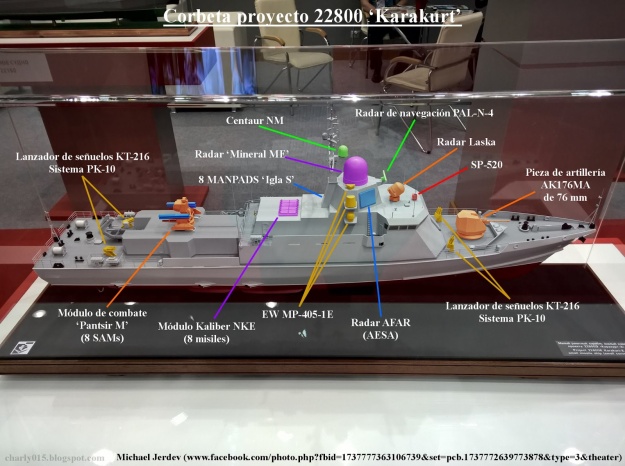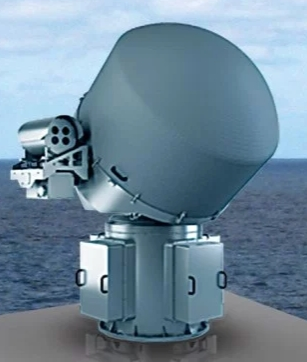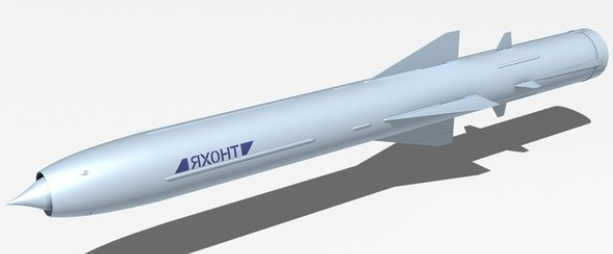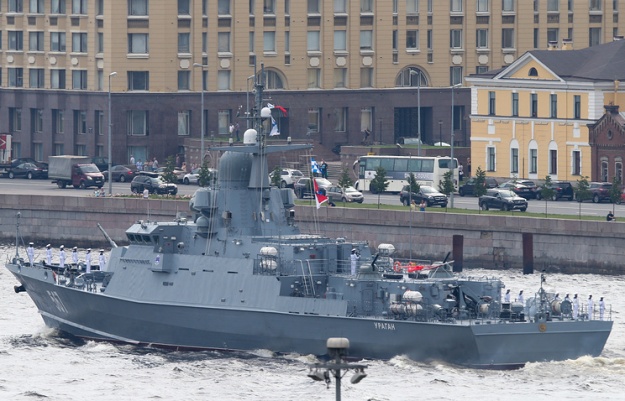The Project 22800 Karakurt-Class guided-missile corvettes are currently under construction for the Russian Navy. The small corvettes are intended to conduct anti-surface and anti-air warfare, as well as coastal surveillance missions in littoral zones.
The keel for the first corvette in class, Uragan (251), was laid at Pella Shipyard in December 2015. The vessel was launched in July 2017 and is scheduled to enter service in 2018. The keel for the second vessel, Typhoon (252), was also laid in December 2015, while the keel laying ceremony for the third corvette, Storm (254), was held at Morye Shipyard in May 2016.
The remaining vessels in class, namely Shkval, Burya and Okhotsk, are also under construction.
A total of 18 Project 22800 Karakurt-Class corvettes are to be included in the Russian Navy’s Black Sea Fleet and Northern Fleet by 2022.
Ships
Project 22800
|
Name
|
Yard №
|
Laid Down
|
Launched
|
Commissioned
|
Note
|
|
Pella Shipyard, Otradnoe – 0+4 units
|
|||||
|
Uragan
|
№251
|
24.12.2015
|
29.07.2017
|
plan 2018
|
under construction, from 5.03.2018 – Mytishchi |
|
Tayfun
|
№252
|
24.12.2015
|
24.11.2017
|
plan 2018
|
under construction, from 5.03.2018 – Sovetsk |
|
Shkval
|
№253
|
29.07.2016
|
5.05.2018
|
–
|
under construction, from 5.03.2018 – Odintsovo |
|
Burya
|
№257
|
24.12.2016
|
–
|
–
|
under construction |
|
Zaliv Shipyard, Kerch – 0+5 units
|
|||||
|
Cyklon?
|
№801
|
2016?
|
08.2018
|
–
|
under construction |
|
–
|
№802
|
2016
|
–
|
–
|
under construction |
|
–
|
№803
|
30.07.2017
|
–
|
–
|
under construction |
|
–
|
№804
|
–
|
–
|
–
|
under construction |
|
–
|
№805
|
–
|
–
|
–
|
under construction |
|
«Morye», Feodosia – 0+3 units
|
|||||
|
Shtorm
|
№254
|
10.05.2016
|
–
|
plan 2018
|
under construction, from 5.03.2018 – Kozelsk |
|
Okhotsk
|
№255
|
17.03.2017
|
–
|
plan 2018
|
under construction |
|
Vikhr
|
№256
|
19.12.2017
|
–
|
план 2020
|
under construction |
Source russianships.info
Total 18 ships to be built
According to TASS Russia’s Project 22800 for the naval forces will get a total of 18 such ships. Source tass.com
Russia Offers Karakurt Corvettes Project 22800E equipped with 76-mm OTO Melara gun to India: Here
Excerpt
According to the information of the Internet portal flotprom.ru, Almaz Central marine design Bureau announced a new export offer – small missile ship (small Corvette) 22800Э project “Karakurt” with the Italian 76-mm gun OTO Melara, MTU diesel engines and electronic weapons Thales. The domestic version of the project 22800При buyers can opt for a modification with Russian engines, gun mounts and radar. The developer believes that the version with foreign components may largely be of interest to customers. In the first place are due to the Indian Navy, as the country, carrying out active re-equipment of the troops, seeks to maximize diversification in the field of armaments and military equipment.
Indian Navy considering Project 22800 corvettes from Russia: Details
Excerpt
Guided missile corvettes from Russia might soon make their way to India, with Russia looking to export its Project 22800 corvettes, code-named ‘Karakurt’, armed with the Kaliber missiles, to countries in the Asia-Pacific region. Apart from India, the corvettes could also be shipped to Vietnam and China.
Project 22800 history
In August 2016, JSC “Zelenodolsk Plant named after AMGorky” was awarded a contract by the Russian Ministry of Defence for the construction of five Project 22800 corvettes for the Russian Navy.
The Russian Ministry of Defence signed agreements with Pella Shipyard and Zelenodolsk Plant during the International Military Technical Forum “Army 2017” for the construction of a series of Project 22800 corvettes.
Karakurt-Class corvettes design
 charly015blogspot.com
charly015blogspot.com
Designed by Almaz Design Bureau, the Karakurt-Class features a stealth superstructure housing an integrated mast mounted with phased array radar panels. The platform is designed to offer high manoeuvrability, stability and sea-keeping capabilities.
The modular design of the ship allows for the development of multiple variants to meet the mission-specific requirements. The ship will be installed with advanced command and control systems, navigation and communication facilities, as well as state-of-the-art weapons
The Project 22800 corvette measures approximately 67m-long and 11m-wide, and has a displacement of 800t.
Sensors
 Uragan (Yard no. 251) 567 and Tayfun (Yard no. 252) 577 only have front facing radar later ships have front and rear facing radar on main mast – Телеканал Звезда
Uragan (Yard no. 251) 567 and Tayfun (Yard no. 252) 577 only have front facing radar later ships have front and rear facing radar on main mast – Телеканал Звезда
Advanced/Airborne Fixed-Array Radar
 Shkval (584) – Телеканал Звезда YouTube
Shkval (584) – Телеканал Звезда YouTube
The Project 22800 Karakurt-class guided missile corvettes in construction for the Russian Navy will receive advance radar capable of acquiring aerial targets at arrange of about 100 km, Alexander Khomyakov, first deputy director general/chief designer, Central Design Bureau of Apparatus Engineering, has told journalists. Source wardefencenews.blogspot.com
“The first production-standard radar has been made to date. It handles aerial targets at a distance of around 100 km, has the identification friend or foe [IFF] system and can monitor the surface of the sea,” Khomyakov said. Source navyrecognition.com
 Rear facing radar 3rd ship onwards – charly015blogspot.com
Rear facing radar 3rd ship onwards – charly015blogspot.com
Mineral-M, radars

MINERAL-ME Shipborne Radar is designed for:
- surface surveillance;
- early (over-the-horizon) detection and tracking of surface targets;
- computer-aided reception and processing of surface surveillance data from platforms with compatible systems;
- reception and processing of data from external sources (automated command control systems, observation posts);
- control over joint operations of platforms with compatible systems;
- generation and output of surface target designation data to weapon control systems of shipborne and coastal missile systems, shipborne artillery and torpedo systems;
- detection and tracking of surface targets;
- ecording and archiving of tracked target data, data on made decisions, and statuses of integrated systems;
- crew training when operating in simulated tactical situation.
Mineral-ME includes:
- Mineral-ME1 Active Radar;
- Mineral-ME2 Passive Radar;
- Mineral-ME3 mutual data exchange, navigation and joint combat operation control station.
 Shkval (584) – Телеканал Звезда YouTube
Shkval (584) – Телеканал Звезда YouTube
| Main specifications | |
| Active radar detection range for surface destroyer-class targets (under best visibility conditions) | up to 250 km |
| Passive radar detection range for emitting radar systems (depends on radar system frequency range) | 80–450 km |
| Special features |
| · Automated reception and processing of surface surveillance data collected from external sources (ships, helicopters, observation posts). |
Data Rosoboronexport
MR-123 radar system (LASKA)

Features
Mission
 Uragan (Yard no. 251) 567 – RussianArms
Uragan (Yard no. 251) 567 – RussianArms
MTK-201M-S1 multifunctional optoelectronic television complex

The system is designed for day and night viewing, detection and identification of air, surface and coastal targets, capture and automatic tracking of targets, determine the angular coordinates, distance and speed of tracked targets.
The complex includes:
– gyro-stabilized platform with channels:
• Digital television cameras in black and white and color images with progressive scan
• thermal imaging channel 8-12 mm
• laser rangefinder, laser rangefinder safe
– Remote control units improve the signal (video processor) and the block automatic tracking of targets
This complex is part of the on-board equipment of a new generation of Russian corvettes.
On the project 20380 corvettes set modification multifunctional television complex of ITC-201M2.2.
 Image: foto-i-mir.ru
Image: foto-i-mir.ru
The structure of “Bark-0-MGKUSO” includes:
1. Optical modules Block stabilized (BOMS), which establishes:
• Stability and Control;
• thermal imaging channel [TPVK);
• TV channel (TCE):
– two TCE black and white image
– TEC color images
• dual-wavelength laser rangefinder;
• devices cleaning of protective hatches;
• a channel alignment
2. Electronic module (ME):
• block the electronic stabilization system;
• the control unit;
• Power Supply
Branch to develop optoelectronic systems of marine and terrestrial purpose of “Production Association” Ural Optical and Mechanical Plant “under the leadership of NI Sheynikova conducted the development and testing of innovative systems sector review for surface ships WF. Creating a product MTK-201M-C1 significantly increase the target detection range and improve the defenses of the ship. Source foto-i-mir.ru


Data Rosoboronexport
PK-10/PU KT-216 Shipborne Decoy Dispensing System

Sigma-E CCS
 Uragan (Yard no. 251) 567 – RussianArms
Uragan (Yard no. 251) 567 – RussianArms
Weapon systems on Project 22800 corvettes
 Uragan (Yard no. 251) 567 – Телеканал Звезда
Uragan (Yard no. 251) 567 – Телеканал Звезда
The primary armament of the Karakurt-Class will be Kalibr-NK cruise missiles fired from an eight-tube UKSK vertical launching system (VLS). The Kalibr-NK missile can engage long-range targets within the distance of approximately 2,500km.
UKSK VLS
 UKSK vertical launching system (VLS) on Uragan (Yard no. 251) 567 – Телеканал Звезда
UKSK vertical launching system (VLS) on Uragan (Yard no. 251) 567 – Телеканал Звезда
Kalibr-NK cruise missiles

The missile is believed to fly 64 ft above the sea and 164 ft above the ground at speeds up to 965 km/hour. It is believed to be guided, using GPS and terminal-phase active radar seekers to achieve a reported three m CEP. The 3M-14K Kalibr-PLis similar to the 3M-14T except that is launched from a submarine. This variant was reported to have been launched from an improved Kilo-class submarine in the Mediterranean to strike targets inside Syria in December 2015. Russia plans to equip most of its submarines and surface ships with the respective versions of the Klub anti-ship and Kalibr land-attack cruise missiles. This will include ships in Russia’s Baltic Sea, Black Sea, Caspian Sea, Northern, and Pacific Fleets. Novator Design Bureau, the designers of the Klub launch system, have developed a shipping container version of the launcher, capable of holding up to four missiles. This shipping container version allows the cruise missile to be forward deployed on ships, trucks, and trains without detection.
Facts
| Russian/NATO Designation | 3M-14 Kalibr/SS-N-30A |
| Variants | 3M-14T Kalibr-NK; 3M-14K Kalibr-PL |
| Mobility and Role | Sea Launched Strategic and Tactical Land-Attack Cruise Missile |
| Designer/Producer | Novator Design Bureau |
| Range | 1,500-2,500 km |
| Warhead Type and Weight | Conventional -450 kg; Reported Nuclear |
| MIRV and Yield | 1 x Unknown |
| Guidance System/Accuracy | Inertial; TERCOM; GPS; Terminal-Phase Active Radar Seeker/Reported 3 m CEP |
| Cruise Altitude | 20 m over sea; 50 m over ground |
| Stages/Propellant | 2/1st liquid-fuel booster; 2nd solid-fuel turbojet engine |
| IOC/Retirement | Oct. 2015/Unknown |
| Status/Number of Units | Operational/Unknown |
| Launch Vehicles | Kalibr-PL (sub-surface ships) – Kilo, Lada, Akula, Yasen, Borei class submarines; Kalibr-NK (surface ships) – Admiral Gorshkov, Admiral Grigorovich, Gepard, Gremyashchy, second batch of Steregushchy, and Buyan-M class ships |
Source missiledefenseadvocacy.org
SS-N-26 (3M55/P-800 Oniks) Anti-Ship Missile

The P-800 Oniks anti-ship cruise missile is a supersonic cruise missile with variants that can be deployed from land or air. Its development began in 1983, and it became operational in 2002. The missile launches from a vertical position and uses angular thrusters located near the nose to reposition itself horizontally and begin its flight path toward the target. The missile then flies at supersonic speeds, can maneuver to avoid air defense, and is resistant to electronic countermeasures. Its ground-based variant, the Yakhont, is placed on a Bastion-P road-mobile launcher as part of a coastal defense system. The Bastion-P, or a TEL vehicle, can carry two of the Yakhont missiles, which can be launched within five seconds of each other. The P-800 Oniks is primarily an anti-ship missile, but has been seeing more use against ground forces in Russia’s ongoing fight against Syrian rebels.
Facts
| Russian/NATO Designation | P-800 Oniks (Land-based Yakhont)/SS-N-26 Strobile |
| Variants | BrahMos |
| Mobility and Role | Surface-to-Surface Anti-Ship Cruise MissileMax Speed 3000 km/h |
| Designer/Producer | NPO Mashinostroyeniya |
| Range | 300km |
| Warhead Type and Weight | 3000kg launch weightHE warhead; Armor-Piercing Warhead |
| Yield | 200kg HE warhead;250 kg Armor-piercing warhead |
| Guidance System/Accuracy | 1.5m CEPSatellite Guidance; Active Radar Seeker |
| Cruise Altitude | Max 14,000m |
| Propellant | Solid-fuel Booster; Liquid-Fuel Ramjet Sustainer |
| IOC/Retirement | 2002/Operational |
| Status/Number of Units | Operational/Unknown |
| Launch Vehicles | Nakat class missile ship; Yasen class submarine;Bastion-P/Bastion-S ground-launch system |
Source missiledefenseadvocacy.org
The corvettes will also be armed with the Pantsir-M missile and anti-aircraft gun complex. It is a naval variant of the Pantsir-S1 combined surface-to-air missile (SAM) and anti-aircraft artillery system developed by KBP Instrument Design Bureau.
Pantsir-M missile and anti-aircraft gun complex
 Shkval (584) – Максим
Shkval (584) – Максим
The Pantsir-M is based on the land based Pantsir-S1, but has a different artillery system- as can be seen on the above pictures, including two GSh-6-30K / AO-18KD 30mm six-barrel guns as found on the Kasthtan CIWS. Pantsir-M also comes with an additional radar system, separate from the one fitted ontop of the turret itself.
The land based Pantsir-S1, produced by Russia’s KBP is a gun-missile system combining a wheeled vehicle mounting a fire-control radar and electro-optical sensor, two 30-mm cannons and up to 12 57E6 radio-command guided short-range missiles, and is designed to take on a variety of targets flying at low altitudes. Link to Pantsir-S1 technical datasheet. Source navyrecognition.com
2 x GSh-6-30K / AO-18KD 30mm six-barrel guns

AO-18K (6K30GSh) 30-mm six-barrel antiaircraft automatic gun is intended for use as armament of KASHTAN CIWS. The automatic gun employs a circuit of multibarrel weapons with a cluster continuously revolving during firing. The automatic mechanisms operate due to the energy of powder gases evacuated from the barrels. Firing is controlled remotely.
TECHNICAL DATA
|
Parameter |
Value |
|
Caliber, mm |
30 |
|
Rate of fire, rpm |
4500…5000 |
|
Muzzle velocity, m/s |
890 |
|
Weight of automatic gun, kg |
230 |
|
Recoil force, kN |
70 |
|
Length, mm |
2600 |
|
Ammunition allowance, cartridges |
500 |
|
Type of cartridges |
fragmentation high-explosive incendiary; fragmentation high-explosive incendiary tracer |
|
Cartridge charge ignition method |
electric |
|
Freed of automatic gun with cartridges |
linkless |
|
Weight of cartridge, kg |
0.83 |
|
DC supply voltage, V |
27 |
|
Compressed air pressure feed to pneumatic starter of automatic gun, kgf/cm2 |
|
|
Cooling of barrel cluster |
Transpiration type |
|
Operating conditions, 0С |
-40…+50 |
Source tulamash.ru
8 x 57E6 radio-command guided short-range missiles

Pantsir-S1 carries up to twelve 57E6 or 57E6-E two-stage solid fuel radio-command-guided surface-to-air missiles in sealed ready-to-launch containers. Missiles are arranged into two six-tube groups on the turret. The missile has a bicalibre body in tandem configuration. The first stage is a booster, providing rapid acceleration within the first 2 second of flight, after it is separated from the sustainer-stage. The sustainer is the highly agile part of the missile and contains the high explosive multiple continuous rod and fragmentation warhead, contact and proximity fuses as also radio transponder and laser responder to be localised for guidance. The missile is not fitted with seeker to keep target engagement costs low. Instead high-precision target and missile tracking is provided via the systems multiband sensor system and guidance data is submitted via radio link for up to four missiles in flight. Missiles can be fired in at up to four targets but also salvos of two missiles at one target. Missile is believed to have a hit probability of 70-95% and have a 15 year storage lifetime in its sealed containers. Pantsir-S1 combat vehicles can fire missiles on the move.

Image vpk.name
 Shkval (584) – Телеканал Звезда
Shkval (584) – Телеканал Звезда
| 57E6 | 57E6E | |
| Length of container, mm | 3,200 | |
| Missile length | 3160 mm | |
| Diameter, 1st stage booster | 170 mm | 90 mm |
| diameter, 2nd stage sustainer | 90 mm | 76 mm |
| Weight, kg: | ||
| in container | 85 | |
| launch | 71 | |
| Weight with TPK | 94 kg | |
| Weight without TPK | 75.7 kg | |
| Warhead weight | 20 | 20 kg |
| Weight explosive, kg | 5.5 | 5.5 kg |
| Range | 1-18 km | |
| height of action | 5-15000 meters | |
| maximum speed | 1,300 m/s | 1300 m / s (at the end of the work starting stage) |
| Average speed | 900 m / s (at a distance of 12 km) | |
| Average speed | 780 at range of 18 km | 780 m / s (at a distance of 18 km) |
| the maximum target speed | 1000 m / s | |
| Speed – ballistic braking | 40 m / s at 1 kilometers (sustainer stage) | |
| The duration of the starting area | with 2.4 | |
| Probability of hitting aerial targets | 0.7-0.95 | |
| CU Type | fragmentation rod warhead may 14F6 | |
| Fuse warhead | contact and non-contact | |
| Fuze type | contact +proximity, radar, adaptive | |
| Fuze radius of action, m | 9 |
Technical specification globalsecurity.org
 Shkval (584) – Телеканал Звезда
Shkval (584) – Телеканал Звезда
The main gun mounted on the forward bow deck will be an AK-176MA 76.2mm automatic gun, which is an upgraded variant of the AK-176 naval gun. It can fire at a rate of 150rpm and can engage targets within the maximum range of 15km.
Its AK-176MA will be housed in a multifaceted turret to deflect electromagnetic waves. The gun will integrate a digital control system and Sfera-2 optronic station to acquire multiple targets at long ranges.
AK-176MA 76.2mm automatic gun
 Tayfun
Tayfun
76 mm shipboard automatic artillery gun mount AK-176M1:
- designed for arming of surface ships, including missile and patrol boats;
- provides effective defeating of aerial, sea and shore-based targets;
- supplied with the automatic command and control system, provides automatic selection of ammunition.
Main characteristics

Source burevestnik.com
AK-630M 30mm close-in weapon systems (CIWS)
Note: Uragan (Yard no. 251) 567 and Tayfun (Yard no. 252) 577 only
 Uragan (Yard no. 251) 567 – Телеканал Звезда
Uragan (Yard no. 251) 567 – Телеканал Звезда
The corvettes will also be mounted with two AK-630M 30mm close-in weapon systems (CIWS), which can strike aerial and surface targets such as anti-ship missiles, aircraft and helicopters, as well as small-size surface vessels, floating mines, and shore-based fire posts.
With a rate of fire of up to 5,000rpm, the CIWS will enable the vessel to engage targets within the range of 5,000m. Other armament aboard the vessel will include two 12.7mm Cord machine guns.
 Uragan (Yard no. 251) 567 – TASS
Uragan (Yard no. 251) 567 – TASS
Propulsion of Karakurt-Class corvettes
The power plant of the Karakurt-Class will integrate three M-507D-1 diesel engines and three DGAS-315 diesel gensets supplied by PAO “Zvezda”.
The propulsion system will enable the ship to attain a maximum speed of 30kt and a range of up to 2,500nmi. The endurance of the corvette will be approximately 15 days.
3 x M-507D-1 diesel engines

M507 – an engine consisting of two 56-cylinder diesel units (diesels), each of them works for its own shaft. The units are connected with each other by a main gearbox, which transmits rotation of crankshafts of the units to the power take-off flange.
Among the main advantages of the model are the integrated reverse reduction gearbox, compact design and low weight along with high output (7355 kW).
 Shkval (584) – Телеканал Звезда
Shkval (584) – Телеканал Звезда
| Continuous (rated) power, kW (rpm) | 7355 (2000) | |
| Fuel consumption (g/kW*hr) | 230 | |
| Rotation speed of crankshaft at astern running (rpm) | 628 | |
| Overall dimensions, mm | Length | 7000 |
| Width | 1820 | |
| Height | 2490 | |
| Weight, kg | 17100 | |
| Time between overhaul, hr | 3500 (unit)6000 ч (gearbox) | |
Technical data shipyard.lv
3 x DGAS-315 diesel-generators

The automated ship diesel generator DHAS-315 is intended for use as the main or backup power source in power plants of ships with an unlimited navigation area.
DGAS-315 consists of a diesel generator with attached auxiliary mechanisms and a local control system, which includes an automation system and a rotational speed control system.
Circulation lubrication system under pressure with a “wet” diesel crankcase. Compressed air starting system.
The diesel generator is automated in the amount of 2 degrees of automation.
Electronic speed control system provides speed control of 1 accuracy class.
Drive engine – 6CHN18 / 20, six-cylinder, single-block with vertical cylinder axes, with direct fuel injection, water-cooled, with gas turbine supercharging and pre-start heating of oil in the crankcase of diesel. Source zvezda.spb.ru
 Uragan (Yard no. 251) 567 – RussianArms
Uragan (Yard no. 251) 567 – RussianArms
General characteristics – Project 22800
| Displacement (tons): | |
| Standard: | – |
| Full load: | 800 |
| Dimensions (m): | |
| Length: | 67 |
| Beam: | 11 |
| Draft: | 3,3 |
| Speed (knots): | 30 |
| Range: | 2500 nmi |
| Autonomy (days): | 12 |
| Propulsion: | 3×10000 hp M-507D-1 diesels, 3 fixed pitch propellers, 1 bow thruster, 3 DGAS-315 diesel-generators x315 kW |
| Armament: | 1×8 UKSK 3K14 VLS («Kalibr-NK» missile complex (8 3M14T missiles)) – «Mineral» fire control system 1×1 76 mm AK-176MA – MR-123-02/3 «Bagira» fire control system 2×6 30 mm AK-630M (Burya, Okhotsk, Shkval- 1 «Pantcir-M» air defense system 1x(8 SAM missiles, 2×6 30 mm) (32 57E6 missiles, 1000 rounds)) 2×1 12,7 mm Kord |
| Electronics: | MTK-201M-S1 multifunctional optoelectronic television complex |
| Complement: | 39 |
Source russianships.info
Main material source naval-technology.com
Images are from public domain or otherwise stated
Revised May 6, 2018
Updated Dec 16, 2018


Pingback: Navele Proiect 22800 Karakurt | RNHS